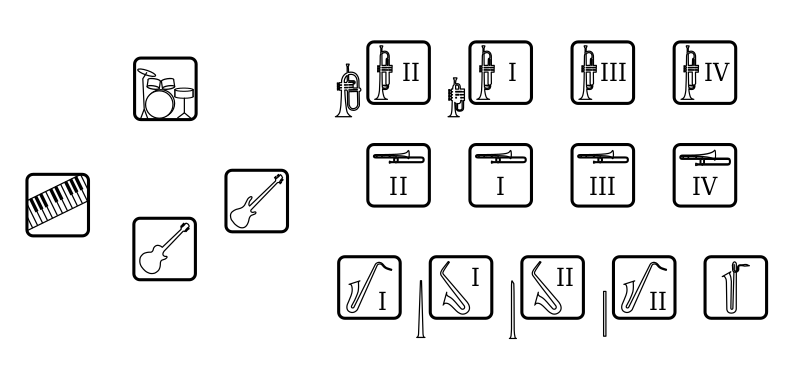Unit 8
Jazz is primarily an American musical art form which originated at the beginning of the 20th century in slave communitiescomunidades de esclavos in the Southern United States from a mix of African and European music traditions. Blues, worksongs, spirituals and gospels are in the rootsraices of jazz.
1900-1930: DIXIELAND
Early Jazz - or Dixieland - developed in the early 20th century (1900 – 1930); its four main influences were ragtime, military brass bandsbandas militares de metales, the blues and gospel music. Improvisation was very important in the early stagesen las etapas tempranas. In Dixieland jazz, musicians all improvised at the same time and the bands were originally small marching bands.
1930-1940: SWING ERA
Jazz is primarily an American musical art form which originated at the beginning of the 20th century in slave communitiescomunidades de esclavos in the Southern United States from a mix of African and European music traditions. Blues, worksongs, spirituals and gospels are in the rootsraices of jazz.
1900-1930: DIXIELAND
Early Jazz - or Dixieland - developed in the early 20th century (1900 – 1930); its four main influences were ragtime, military brass bandsbandas militares de metales, the blues and gospel music. Improvisation was very important in the early stagesen las etapas tempranas. In Dixieland jazz, musicians all improvised at the same time and the bands were originally small marching bands.
1930-1940: SWING ERA
By the swing era (1930-1940) big bands were beginning to depend on arranged musicmúsica arreglada, escrita: arrangementslos arreglos were written or learned by ear and memorized - many early jazz performers could not read music. The most common number of instruments in a big band was (and still is) 17:
- Five saxophones (two alto saxes, two tenor saxes and one baritone sax)
- Four trumpets
- Four trombones
- Four "rhythm" instruments (piano, bass, drums, guitar).
"Call and Responsepregunta y respuesta" was a common musical theme: one section (say, the brass section, i.e., trumpets and trombones) would play a musical phrase and it would be “answered” by another section (say, the saxes); the first phrase is the call, the answer is the response (like a musical conversation).
1940-1960: BEBOP AND COOL JAZZ
1940-1960: BEBOP AND COOL JAZZ
Bebop became important from 1940 – 1955. Bebop was primarily played by small groups (combos). A typical Bebop combo consists of two wind instruments (e.g., trumpet and saxophone) and rhythm section (piano, bass and drums).
Jam sessions are informal concerts where the musicians play together, challengeto challenge: retar each other and learn from each other. Bebop was, and still is, the music that is most played at jazz jam sessions because all the musicians need to know the song's main melody and chords.
Scat singing is a vocal style where the vocalist imitates the style of Bebop jazz solos (as played by instrumentalists) using nonsense syllablessílabas sin sentido. Scat solos, like their instrumental counterparts, are improvised. One of the most important scat singers was Ella Fitzgerald.
Whereasmientras Big Band Swing was considered entertainmententretenimiento (i.e., dance music), Bebop was considered art music (like classical music, bebop was for listening only); Bebop musicians considered themselves artists, not merely entertainers.
Cool Jazz was developed from 1949 – 1955. Whereas Bebop was “hot” (i.e., loud, exciting and loose), Cool Jazz was “cool” (i.e., soft, more reserved and controlled). Two important aspects in Cool jazz is the improvisation and the arrangement. Cool Jazz was a blendingmezcla of jazz and classical music.
1960-1990: FREE JAZZ AND FUSION
1960-1990: FREE JAZZ AND FUSION
Free Jazz was the most popular style from 1959 – 1970. UnlikeA diferencia de previous styles of jazz whose compositions were based on a series of predetermined chords. Free Jazz compositions were not based on anything. It was called Free Jazz because the musicians were "free" to play whatever they wanted.
Fusion is the blending of jazz with other styles like rock, pop, flamenco, etc.
PRACTICE
Big Duke Band
PRACTICE
Big Duke Band






